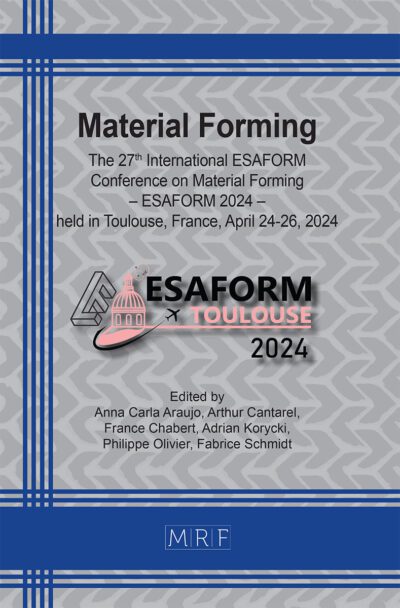Analysis of friction properties of DC04 using pin extrusion test with modified parameters
Marion VOGEL, Keyu LUO, Birgit VOGEL-HEUSER, Marion MERKLEIN
Abstract. The current economic and ecological trend towards lightweight construction and functional integration is constantly increasing. In order to produce components with near-net-shape geometries in an eco-friendly process, forging is the ideal solution. The Sheet-Bulk metal forming (SBMF) process, which combines the benefits of both sheet metal and bulk metal forming, is an advantage in this context. To accurately replicate numerical simulation models as realistically as possible, it is essential to make adjustments to the parameters. Especially friction that occurs between the tool and the workpiece plays a critical role. It can affect the material flow as well as tool wear and product quality. Various methods can be employed to determine the friction factor, such as the ring compression test or the pin extrusion test. Both are suitable for investigating the tribological conditions in the SMBF. As the pin extrusion test is a full forward extrusion process that produces a pin, this process is suitable for the procedure to be used in the following studies. The objective of this research is to quantify the effects on friction by systematically varying modified parameters such as temperature, forming velocity and amount of lubricant, and integrate these findings into simulation models in the pin extrusion test. For this purpose, the pin extrusion test was first modeled numerically by using the simulation software Simufact.Forming. In order to validate the simulation model, experiments were conducted on a hydraulic deep-drawing press. The material DC04 was used for the drawing tests. It was possible to analyse the changes in the friction factor with additional influence on the manufactured geometry and its surface roughness.
Keywords
Friction, Numerical Model, Pin Extrusion
Published online 5/7/2025, 10 pages
Copyright © 2025 by the author(s)
Published under license by Materials Research Forum LLC., Millersville PA, USA
Citation: Marion VOGEL, Keyu LUO, Birgit VOGEL-HEUSER, Marion MERKLEIN, Analysis of friction properties of DC04 using pin extrusion test with modified parameters, Materials Research Proceedings, Vol. 54, pp 1096-1105, 2025
DOI: https://doi.org/10.21741/9781644903599-119
The article was published as article 119 of the book Material Forming
![]() Content from this work may be used under the terms of the Creative Commons Attribution 3.0 license. Any further distribution of this work must maintain attribution to the author(s) and the title of the work, journal citation and DOI.
Content from this work may be used under the terms of the Creative Commons Attribution 3.0 license. Any further distribution of this work must maintain attribution to the author(s) and the title of the work, journal citation and DOI.
References
[1] A. E. Tekkaya, N. B. Khalifa, G. Grzancic, R. Hölker, Forming of Lightweight Metal Components: Need for New Technologies. Procedia Engineering 81 (2014) 28-37. https://doi.org/10.1016/j.proeng.2014.09.125
[2] S. M. Schaper, Y. Lizunkova, M. Vucetic, T. Cahyono, H. Hetzner, S. Opel, J. Schneider, T. Koch, B. Plugge, Sheet-bulk Metal Forming a New Process for the Production of Sheet Metal Parts with Functional Components. Metallurgical and Mining Industry 3 (2011) 7, 53 58
[3] K. Lange, M. Kammerer, K. Pöhlandt, J. Schöck, Fließpressen – Wirtschaftliche Fertigung metallischer Präzisionswerkstücke, Springer, Berlin, 2008. https://doi.org/10.1007/978-3-540-30910-9_6
[4] W. B. Andrew, W. S. Gwidon, Tribology in materials processing. Journal of Materials Processing Technology 48 (1995), 503-515. https://doi.org/10.1016/0924-0136(94)01689 X
[5] X.-C. Zhuang, H. Xiang, Z. Zhao, Analysis of sheet metal extrusion process using finite element method. International Journal of Automation and Computing (2010), 295-302. https://doi.org/10.1007/s11633-010-0506-8
[6] H. U. Vierzigmann, Beitrag zur Untersuchung der tribologischen Bedingungen in der Blechmassivumformung – Bereitstellung von tribologischen Modellversuchen und Realisierung von Tailored Surfaces. PhD Thesis FAU 288 (2015)
[7] M. Löffler, Steuerung von Blechmassivumformprozessen durch maßgeschneiderte tribologische Systeme. PhD Thesis FAU 308 (2018)
[8] A. E. Tekkaya, A guide for validation of FE-Simulations in bulk metal forming. The Arabian Journal for Science and Engineering 30 (2005) 113-136
[9] P. Hetz, M. Kraus, M. Merklein, Characterization of sheet metal components by using an upsetting test with miniaturized cylindrical specimen. CIRP Annals – Manufacturing Technology 71 (2022) 233-236. https://doi.org/10.1016/j.cirp.2022.03.010
[10] DIN Deutsches Institut für Normung e.V., DIN EN ISO 14577-1:2024, Metallische Werkstoffe – Instrumentierte Eindringprüfung zur Bestimmung der Härte und anderer Werkstoffparameter – Teil 1: Prüfverfahren, Beuth-Verlag, Berlin, 2024
[11] J. A. Lichtenfeld, M. C. Mataya, C. J. van Tyne, Effect of Strain Rate on Stress-Strain Behavior of Alloy 309 and 304L Austenitic Stainless Steel. Metallurgical and Materials Transactions (2006) 147-161. https://doi.org/10.1007/s11661-006-0160-5
[12] Y. Zhu, S. Zhu, X. Zhuang, Z. Zhao, Die structure optimization for eliminating premature folding of sidewall upsetting with a controllable deformation zone. The International Journal of Advanced Manufacturing Technology 105 (2019) 1411-1424. https://doi.org/10.1007/s00170-019-04331-8
[13] A. Farhoumand, R. Ebrahimi, Analysis of forward–backward-radial extrusion process. Materials and Design 30 (2009) 2152-2157. https://doi.org/10.1016/j.matdes.2008.08.025
[14] Z. Cai, Y. Zhou, J. Qu, Effect of oil temperature on tribological behavior of a lubricated steel−steel contact. Wear 332-333 (2015) 1158-1163. https://doi.org/10.1007/s00170-019-04331-8














